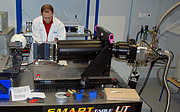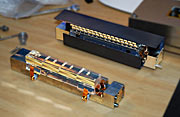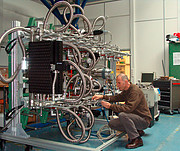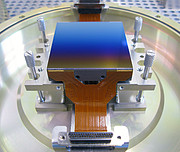Meddelelse
A Muse for the Very Large Telescope
1. marts 2010
The first components for the Multi Unit Spectroscopic Explorer (MUSE), a second generation instrument for ESO’s Very Large Telescope (VLT), are beginning to arrive. MUSE is an innovative 3D spectrograph with a wide field of view, providing simultaneous spectra of numerous adjacent regions in the sky. Such spectrographs are efficient explorers of the Universe in three dimensions (two for the on-sky positions, and one for the wavelengths). Poised to become a unique and powerful tool for discovering objects that cannot be found in imaging surveys, MUSE, which is based on a number of innovative technological developments, is bringing these advantages to a level never achieved before.
“After many years of hard work, it is with great satisfaction that we see this dream becoming reality,” says Roland Bacon, who is leading the development of this instrument. “The MUSE concept, with its serial production of not just one, but 24, 3D spectrographs, is new in optical astronomy and it constitutes a key experience in view of the next generation of instruments, both for the VLT as well as for the proposed European Extremely Large Telescope.”
MUSE combines 24 spectrographs in order to be able to probe a field of view as large as possible. High optical efficiency is maintained with image slicers, a new technology, and MUSE is using the largest image slicers ever used in astronomy. Each spectrograph is equipped with 4000 x 4000 pixel detectors — the largest detectors used at ESO.
Between the end of 2009 and beginning of 2010 two important MUSE milestones were achieved: 24 high performance detectors were delivered to ESO by e2v and the first of 24 3D spectrographs was delivered by Winlight Optics to the team at the CRAL (Lyon, France) where it was completely assembled with the detector and fully tested. The resulting spectra confirmed the superb image quality of the spectrograph as well as the proper working of the system. “This means we can now give the go-ahead for the serial production of the next 23 spectrographs at the optics manufacturer Winlight,” says Luca Pasquini, from ESO.
In parallel, at ESO, the full cryogenic system, which will handle the 24 detectors and their cryostats, was assembled and successfully tested. After completion of some further tests, it will be shipped to CRAL for the final integration of the instrument.
Distant galaxies appear tiny when observed from Earth, and their images are blurred by the Earth’s atmosphere, making their study highly challenging. MUSE will use an innovative adaptive optics system that will correct for the perturbations due to the atmosphere in real time. The performance of MUSE should thus allow the detection of galaxies that appear a hundred million times fainter than the faintest stars observable with the unaided eye.
Started in 2004, the instrument will see its first light in 2012 at the VLT site (Paranal) in Chile. “This will be the beginning of a concerted hunt for young and distant galaxies, the goal being to attack the fundamental questions of the early stages of galaxy formation and evolution,” says Bacon. “But MUSE will also be an efficient tool with which to tackle astrophysical problems in many other fields.”
For instance, the MUSE consortium plans to study the environment of supermassive black holes, which are assumed to be present in most galactic nuclei, as well as to examine in great detail the stellar populations of nearby galaxies. The MUSE spectrograph will of course also be opened to the ESO scientific community at large.
This unique and ambitious project is supported by seven major European research institutes: the Centre de Recherche Astrophysique de Lyon (CRAL CNRS/University Claude-Bernard Lyon I — France) which is the leading institute, the European Southern Observatory (ESO), the Leiden Observatory (NOVA — Netherlands), the Laboratoire d’Astrophysique de Toulouse-Tarbes (CNRS/University Paul Sabatier — France), the Institut für Astrophysik (Georg-August University of Göttingen — Germany), the Institute for Astronomy at ETH, Zurich (Switzerland) and the Astrophysikalisches Institut Potsdam (Germany). The MUSE consortium brings together more than a hundred scientists and engineers who cover all the required expertise to build and exploit this unique instrument: optics, mechanics, electronics, cryogenics, signal processing, management, observational and theoretical astrophysics.
Links
Kontakter
Roland Bacon
CRAL, France
Phone: +33 6.08.09.14.27
E-mail: rmb@obs.univ-lyon1.fr
Luca Pasquini
ESO
Phone: +49 89 3200 6792
E-mail: lpasquin@eso.org
Henri Boffin
ESO ePOD
Phone: +49 89 3200 6222
Cell: +49 174 515 43 24
E-mail: hboffin@eso.org
Om meddelelsen
| Id: | ann1012 |
Our use of Cookies
We use cookies that are essential for accessing our websites and using our services. We also use cookies to analyse, measure and improve our websites’ performance, to enable content sharing via social media and to display media content hosted on third-party platforms.
ESO Cookies Policy
The European Organisation for Astronomical Research in the Southern Hemisphere (ESO) is the pre-eminent intergovernmental science and technology organisation in astronomy. It carries out an ambitious programme focused on the design, construction and operation of powerful ground-based observing facilities for astronomy.
This Cookies Policy is intended to provide clarity by outlining the cookies used on the ESO public websites, their functions, the options you have for controlling them, and the ways you can contact us for additional details.
What are cookies?
Cookies are small pieces of data stored on your device by websites you visit. They serve various purposes, such as remembering login credentials and preferences and enhance your browsing experience.
Categories of cookies we use
Essential cookies (always active): These cookies are strictly necessary for the proper functioning of our website. Without these cookies, the website cannot operate correctly, and certain services, such as logging in or accessing secure areas, may not be available; because they are essential for the website’s operation, they cannot be disabled.
Functional Cookies: These cookies enhance your browsing experience by enabling additional features and personalization, such as remembering your preferences and settings. While not strictly necessary for the website to function, they improve usability and convenience; these cookies are only placed if you provide your consent.
Analytics cookies: These cookies collect information about how visitors interact with our website, such as which pages are visited most often and how users navigate the site. This data helps us improve website performance, optimize content, and enhance the user experience; these cookies are only placed if you provide your consent. We use the following analytics cookies.
Matomo Cookies:
This website uses Matomo (formerly Piwik), an open source software which enables the statistical analysis of website visits. Matomo uses cookies (text files) which are saved on your computer and which allow us to analyze how you use our website. The website user information generated by the cookies will only be saved on the servers of our IT Department. We use this information to analyze www.eso.org visits and to prepare reports on website activities. These data will not be disclosed to third parties.
On behalf of ESO, Matomo will use this information for the purpose of evaluating your use of the website, compiling reports on website activity and providing other services relating to website activity and internet usage.
Matomo cookies settings:
Additional Third-party cookies on ESO websites: some of our pages display content from external providers, e.g. YouTube.
Such third-party services are outside of ESO control and may, at any time, change their terms of service, use of cookies, etc.
YouTube: Some videos on the ESO website are embedded from ESO’s official YouTube channel. We have enabled YouTube’s privacy-enhanced mode, meaning that no cookies are set unless the user actively clicks on the video to play it. Additionally, in this mode, YouTube does not store any personally identifiable cookie data for embedded video playbacks. For more details, please refer to YouTube’s embedding videos information page.
Cookies can also be classified based on the following elements.
Regarding the domain, there are:
- First-party cookies, set by the website you are currently visiting. They are stored by the same domain that you are browsing and are used to enhance your experience on that site;
- Third-party cookies, set by a domain other than the one you are currently visiting.
As for their duration, cookies can be:
- Browser-session cookies, which are deleted when the user closes the browser;
- Stored cookies, which stay on the user's device for a predetermined period of time.
How to manage cookies
Cookie settings: You can modify your cookie choices for the ESO webpages at any time by clicking on the link Cookie settings at the bottom of any page.
In your browser: If you wish to delete cookies or instruct your browser to delete or block cookies by default, please visit the help pages of your browser:
Please be aware that if you delete or decline cookies, certain functionalities of our website may be not be available and your browsing experience may be affected.
You can set most browsers to prevent any cookies being placed on your device, but you may then have to manually adjust some preferences every time you visit a site/page. And some services and functionalities may not work properly at all (e.g. profile logging-in, shop check out).
Updates to the ESO Cookies Policy
The ESO Cookies Policy may be subject to future updates, which will be made available on this page.
Additional information
For any queries related to cookies, please contact: pdprATesoDOTorg.
As ESO public webpages are managed by our Department of Communication, your questions will be dealt with the support of the said Department.




